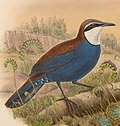Jewel-babbler
| Jewel-babblers | |
|---|---|

| |
| Spotted jewel-babbler (Ptilorrhoa leucosticta) | |
| Scientific classification | |
| Domain: | Eukaryota |
| Kingdom: | Animalia |
| Phylum: | Chordata |
| Class: | Aves |
| Order: | Passeriformes |
| Family: | Cinclosomatidae |
| Genus: | Ptilorrhoa J.L. Peters , 1940
|
| Type species | |
| Eupetes caerulescens[1] Temminck, 1836
| |
| Species | |
|
4, see text | |

| |
| Global range (In red) | |
The jewel-babblers are the bird genus Ptilorrhoa in the family Cinclosomatidae. The genus contains four species that are endemic to New Guinea. The genus was once considered to contain the rail-babbler,[2] but that species is now considered to belong to its own family. The genus is closely related to the better known quail-thrushes (Cinclosoma) of New Guinea and Australia. Together with a number of other genera they comprise the family Cinclosomatidae, although the validity of this family as a whole has been questioned.
The jewel-babblers resemble the quail-thrushes in shape, being plump, long-tailed and short winged. They are adapted to life on the forest floor. The
The jewel-babblers as a whole are not a well known or studied genus.
It contains the following species:
| Image | Common Name | Scientific name | Distribution |
|---|---|---|---|
 |
Spotted jewel-babbler | Ptilorrhoa leucosticta | Highland forest, New Guinea |
 |
Blue jewel-babbler | Ptilorrhoa caerulescens | subtropical or tropical moist lowland forests, New Guinea |
| Brown-headed jewel-babbler | Ptilorrhoa geislerorum | New Guinea | |
 |
Chestnut-backed jewel-babbler | Ptilorrhoa castanonota | subtropical or tropical moist lowland forests, New Guinea |
References
- ^ "Cinclosomatidae". aviansystematics.org. The Trust for Avian Systematics. Retrieved 2023-07-16.
- JSTOR 4078852.
- Del Hoyo, J.; Elliot, A. & Christie D. (editors). (2007). ISBN 978-84-96553-42-2
